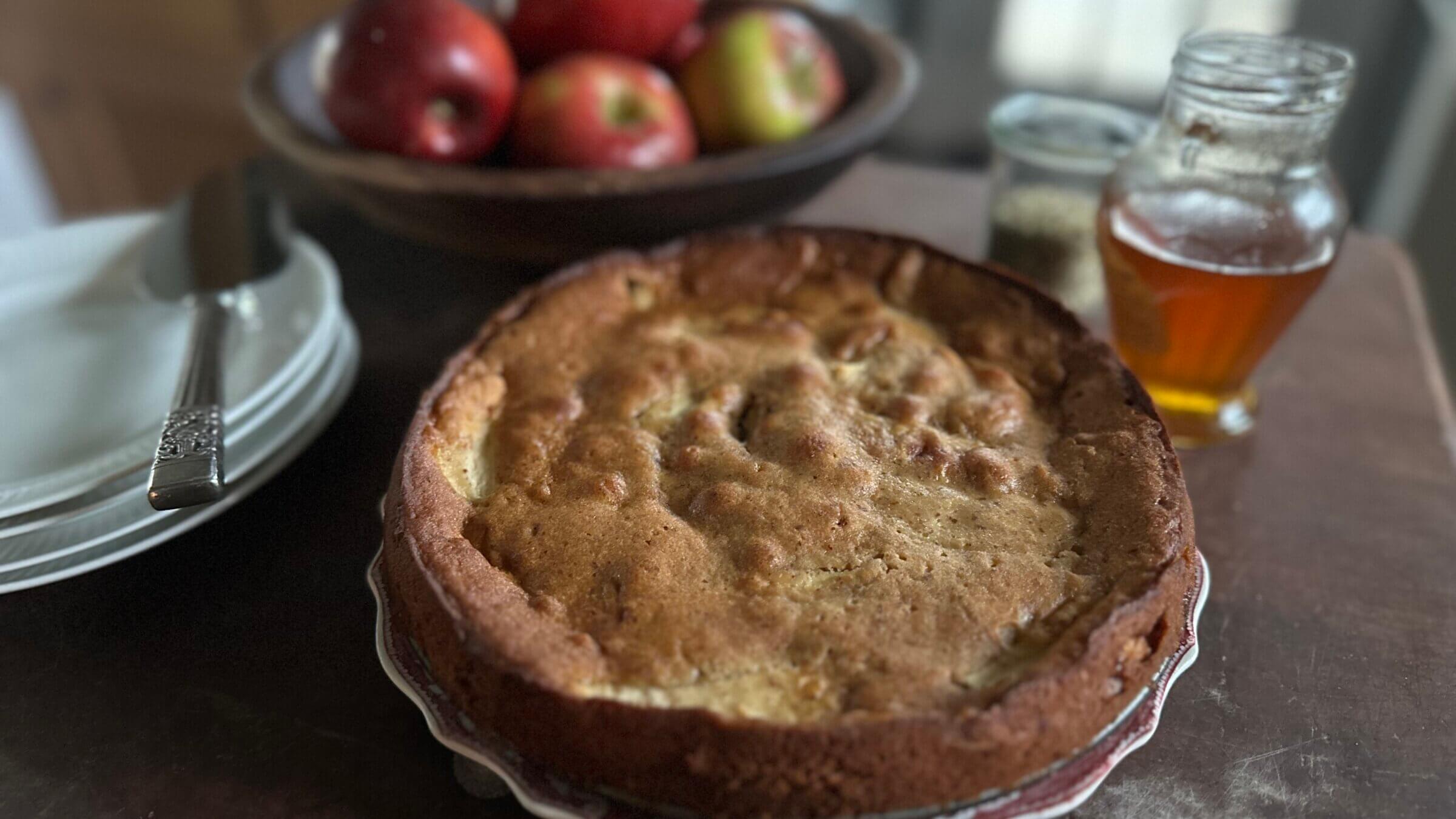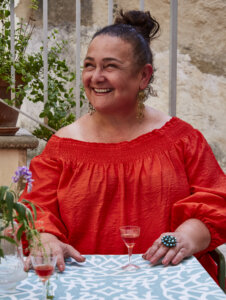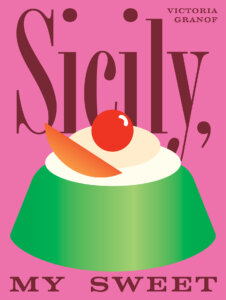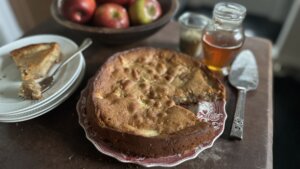In a new cookbook, the forgotten Jewish roots of a Sicilian and her sweets
Plus, a recipe for apple and thyme honey cake with toasted fennel and almonds

A taste of honey, apples and thyme from Victoria Granof’s ‘Sicily, My Sweet.’ Photo by Liza Schoenfein
In her vibrant new cookbook, Sicily, My Sweet — and throughout a recent conversation — author Victoria Granof makes multiple references to sense memory. After all, it was that collection of smells, sounds, tastes and feelings that ultimately helped unearth her Sicilian roots.
“Up until Ancestry.com, when we were actually able to do our DNA and confirm the suspicions, we just assumed that all our sense memories were Turkish,” she told me. “I’ve always yearned for my roots.”
The trouble was, all that remained were those elusive sense memories — and she just couldn’t place them.
Like so many Jewish families, her progenitors fled the vast Spanish kingdom for the Ottoman Empire during the Inquisition. Spain ruled not only the Iberian peninsula, but much of the Americas, parts of North Africa, and about half of Italy, including Naples, Sardinia, and Sicily.
“Once I started researching, I said ‘I’m going to go to Istanbul and find this feeling of connectedness to the food there,’” she says. “And I went there and I thought, ‘Oh, this isn’t it.’”
The place didn’t smell like home. Plus, they served their mezze cold. “I was like, ‘Wait a minute, we never eat anything cold,’” she said.
In retrospect, there were breadcrumbs to follow: “So much of the Ladino language that our family speaks was a lot of Sicilian dialect — it was Italian instead of Spanish.”
Back from Turkey — and having already made an unsuccessful trip to Italy in search of ancestral clues — Granof was working as a pastry chef in L.A. when she happened upon a copy of Gourmet magazine with a story about a baker in Western Sicily who’d grown up in a convent, where she learned to make traditional Sicilian pastries from the nuns. The baker, Maria Grammatico, opened her own eponymous pasticceria in the 1960s, and worried that the craft might die with her.

Granoff was struck by the notion that she might be the one to carry it on.
“I was not looking for my roots at this point,” she said. “I was looking for this pastry chef who was lamenting that she couldn’t pass this art onto anyone else.”
But Granof had only to disembark from the plane before she was hit with a powerful feeling of recognition.
“Landing at the airport in Catania,” she writes in Sicily, My Sweet, “I found that it smelled like coffee, almonds, lemon, and cinnamon — and, somewhere in my sense memory, of home.”
Adding to the wonderment, Granof observed a little girl running through the airport with her grandmother in tow calling, “Vittuccia!” — a diminutive of Vittoria, the Italian version of Granof’s own first name. “I went ‘gasp!’,” she said.
Later, Granof found herself walking alone on a side street in Taormina where she had another remarkable encounter. “Our songs are very different from the Ashkenazic ones — they’re more Arabic than anything else,” she said. “And it was a Friday night, and all of a sudden I heard the song.”
It was familiar, much like the ones her family sang. “I never figured out where it came from,” she said.
On the same walk she passed a post office with the star of David on it, adjacent to a couple of small houses set back from the main road — a street called Vicolo degli Ebrei. “It was the little Jewish quarter,” she said. There was now little doubt in her mind: She was Sicilian.
“We were there 2,000 years ago when Greeks brought honey and almonds to the Island,” she writes in the book’s introduction, referring to Sicily’s Jewish population. “We were there during the Golden Age of Islam, when the Arabs brought over sugar and flower essences and made ices and ice creams. We were there when a brief French occupation brought with it bignè, and brioche; and when Sicily became part of the Spanish Empire, chocolate made its way back from Mexico with the conquistadors and into Sicilian sweets.”

Several recipes in the book reflect Granof’s Sicilian-Jewish roots — though she’s quick to point out that the same recipes might be made and served in Catholic households, since Sicilian cooking is inextricably tied to the land and the seasons. “So we would have the same food for Passover as they had for Easter,” she said.
There’s sfinci for Hanukkah — the same ricotta-filled puffs Sicilians eat for Saint Joseph’s Day: “True to the spirit of multi-culti Sicily,” she writes, “these are a French pastry with a Sicilian filling, an Arabic name, and a legacy tied to the Jews who once ran Sicily’s thriving sugar industry.” They pop up for the Catholic holiday, and similar doughnuts, called sfinj, are made in Morocco during Hanukkah. “Sfinj came to Morocco with the Spanish Moors in probably the same way sfinci arrived in Sicily.”
There’s Ricotta Cheesecake for Passover — gattò di ricotta — made with a matzo-meal crust, rather than the more traditional one made with breadcrumbs.
And there are Lemon and Anise Pastries for Easter and Purim — pupi cu l’ova in Italian, which translates to “dolls with an egg”.
“All over the world, eggs are eaten as the symbol of rebirth,” Granofff writes, adding that these pastries — each containing a small hard-boiled egg at its center — are made at Easter in various shapes, and that her own grandmother made them for Purim, calling them ojos de Haman, or “eyes of Haman.”
And then there is the perfect-for-Rosh Hashanah Apple and Thyme Honey Cake With Toasted Fennel and Almonds — torta mele-miele.
This is not a typical Sicilian apple cake, which Granoff considers meh. It was inspired by a croissant she had for breakfast at Caffé Sicilia in Noto. “That thing was a revelation,” she said. “Wild thyme and thyme honey are very big on the Eastern side of Sicily. I was really influenced and inspired by that croissant.”

Victoria Granof’s Apple and Thyme Honey Cake With Toasted Fennel and Almonds (torta mele-miele)
Makes one 8-inch (20 cm) round cake ONE 8-INCH (20 CM) ROUND CAKE
If you mistakenly set your car’s GPS to avoid major highways on your way to, let’s say, the Catania airport from Modica, you will find yourself driving high up into the Monti Iblei, the Hyblaean Mountains. There, growing spontaneously through craggy rock formations, is wild—and very ancient—thyme. For centuries, Sicilian black bees have fed on its nectar to make the prized and highly aromatic miele di timo, or Sicilian thyme honey. Colony collapse, climate change, wildfires, and even certain agricultural innovations have destroyed much of this wild herb, threatening the survival of the black bees and making miele di timo increasingly rare. Greek thyme honey is a good substitute and is widely available in health food stores and in Greek and international groceries.
As you careen down those narrow mountain roads in late summer, masses of wild fennel, leggy and dry and beginning to go to seed, grow tall and insistent at the borders of the road. The strade provinciali are so narrow up there that you can reach your hand out the window and grab crowns of dry fennel flowers, loaded with seeds. Many varieties of heirloom apples, brought to Sicily by the Normans in the eleventh century, thrive in the high altitudes around Mount Etna. That four-and-a-half-hour detour, and the wholemeal croissants with dried wild herbs and honey at the Caffè Sicilia in Noto, inspired the creation of this cake. It gets moister and more flavorful as it sits, which so far, in my home, has never been more than two days. — Victoria Granof
INGREDIENTS:
½ cup (113 g) unsalted butter, softened, plus more for the pan
1 teaspoon fennel seeds
2 medium tart apples, such as Granny Smith
½ cup (125 g) miele di timo (thyme honey)
¼ cup (50 g) sugar
Grated zest of 1 lemon
2 eggs
½ teaspoon fine sea salt
½ teaspoon ground coriander
1 cup (120 g) all-purpose flour, or ½ cup plus 2 tablespoons (73 g) 00 flour
1/2 cup (50 g) almond flour
2 teaspoons baking powder
¼ cup (60 ml) milk
Preheat the oven to 350˚F (180˚C). Grease an 8-inch (20 cm) springform pan with butter.
Toast the fennel seeds in a small skillet over medium heat, stirring, until they begin to pop and become fragrant. Transfer to a plate and cool, then crush them with a mortar and pestle or in a spice grinder.
Peel, core, and slice the apples about ¼ inch (6 mm) thick. You should have 2 cups. Set aside.
In the bowl of a stand mixer, beat the butter with the honey, sugar, and lemon zest until light. Beat in the eggs one at a time, mixing well after each addition. Stir in the salt, crushed fennel seeds, and coriander.
In a separate bowl, combine the all-purpose flour, almond flour, and baking powder. Add half the dry ingredients to the egg mixture, then half of the milk, stirring after each addition. Repeat with the remaining dry ingredients and milk. Stir in the apples and scrape the batter into the prepared pan. Bake for 50 to 55 minutes, until the cake is nicely browned and fragrant and the top springs back when you touch it lightly. Cool in the pan for 5 minutes, then remove the springform and cool completely.=
The cake will keep at room temperature for 3 days. After that, store tightly wrapped in the fridge for up to a week.
Excerpted with permission from Sicily, My Sweet: Love Notes to an Island, with Recipes for Cakes, Cookies, Puddings, and Preserves by: Victoria Granof published by Hardie Grant Publishing.
A message from our Publisher & CEO Rachel Fishman Feddersen

I hope you appreciated this article. Before you go, I’d like to ask you to please support the Forward’s award-winning, nonprofit journalism so that we can be prepared for whatever news 2025 brings.
At a time when other newsrooms are closing or cutting back, the Forward has removed its paywall and invested additional resources to report on the ground from Israel and around the U.S. on the impact of the war, rising antisemitism and polarized discourse.
Readers like you make it all possible. Support our work by becoming a Forward Member and connect with our journalism and your community.
— Rachel Fishman Feddersen, Publisher and CEO






























